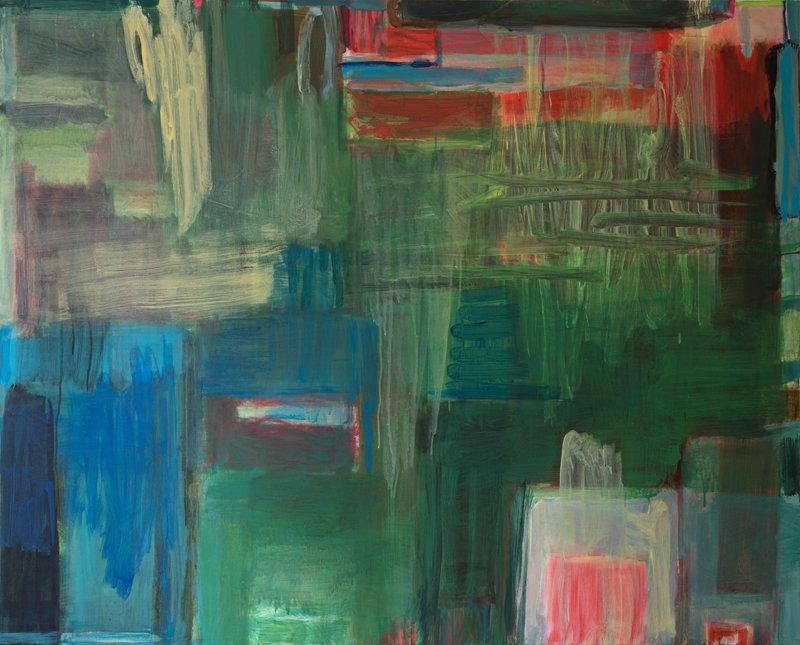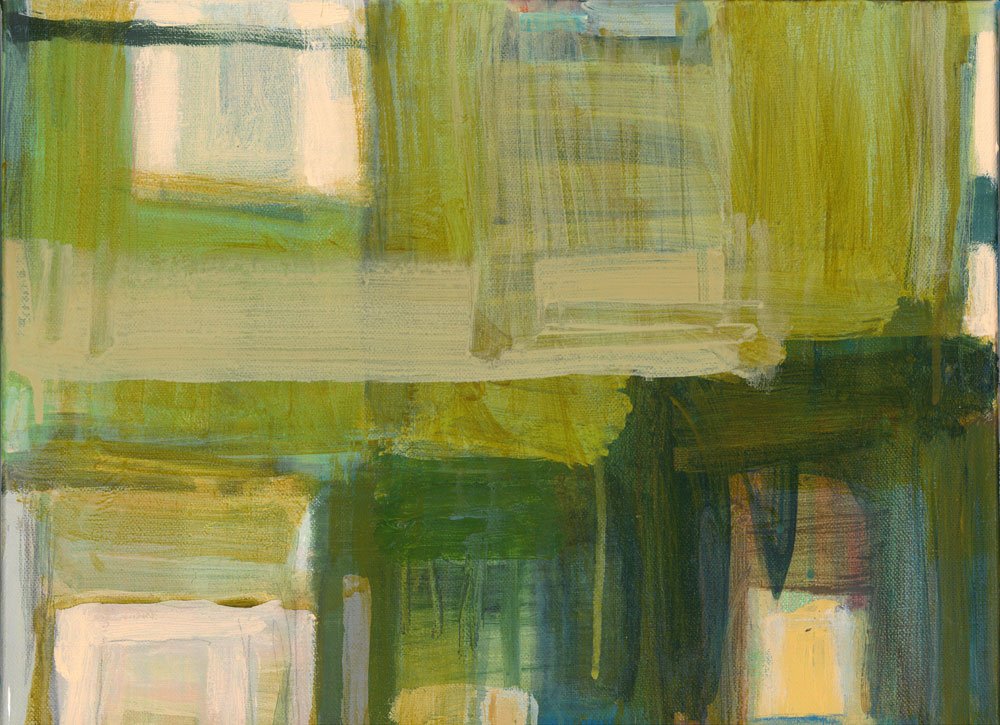Kate Scott uses layers of paint to represent the passage of time in bold, colourful works that speak of grief, resilience and transcendence. She has written: “Painting (for me) is like reverse onion peeling, with each covering of paint revealing more of the truth, and the core of whatever one is trying to say, through adding layers you are also removing layers, showing your passage through time.”
The title describes a crossing over in time for her in the last year or two since her mother’s illness and death. “It’s a metaphor for how I feel about life. I have become very resilient, and I’m someone who always believes I can get through difficult things, I alchemise experiences through my work, which is a hugely positive way for me to process.” she says.
She painted ‘Partitioning’ when her mother only had six weeks to live. It started out a glossy dark blue, quite male, and elegant. Then a few days before her mother died, she mixed up a soft peachy pink which went everywhere, with vertical lines carved through it. “It was flooding with light. It felt like something transcending from being very heavy and held down and dark to being lifted up and almost floating off. It was about how I felt inside myself as I moved from being daughter of a mother who is alive to letting her go.”
There is a strong connection between Scott’s emotional and physical state and her artwork. If a mark doesn’t mean anything, she will wipe it away; it must speak to her to earn its place. “I like accidents and drips, but I would never do it just for decoration. It must have a resonance,” she says.
Working from her converted studio at home, Scott always listens to music, mainly classical composers to help open a part of her brain from which the painting flows. Play, drawing and being experimental are extremely important, “the work emerges through a process of addition and subtraction and some risk taking”. Painting in acrylics allows Scott to work quickly. She begins with random washes of colour and rarely has a plan in mind; if there is one, she doesn’t stick to it. Her process is like a conversation or dance. If a colour doesn’t work, at least it takes her to the next step, like a pendulum. A painting is complete once it stops talking to her which could be within one session, days, or weeks. It is important to her to be brave and raw and create work that is a bit uncomfortable. While on one level her work may seem random, she believes most abstract paintings have a sort of logic to them. “I don’t think anything is random, it’s all to do with what we humans recognise as interesting or beautiful or arresting or calming or exciting and it’s connected to nature and what we see and that’s why it works.”
Although her paintings are abstract, there are discernible figures. These silhouette shapes appeared after the death of her mother, who was a great encourager of her art, and they feel like her mother’s presence in her works. There are also outlines of windows and doors, inspired by the work of painters like Edward Hopper, Henri Matisse and Willem De Kooning whose art contains a lot of structure and architecture. Ivon Hitchens is another important influence. Water is another inspiration, as well as walking, listening to the rain, or being enthralled by music. “I like that visceral feeling of how I blend into nature. It’s my experience of being alive,” says Scott.
While many of her works are in greens and blues, ‘Summer Song’ is made up of pinks and rich yellowy orange colours, giving a sense of the physical warmth of femininity without being sickly or pretty. ‘Changeling’ has been at least three different paintings in its lifetime, transitioning from bright green, to encompassing a scarlet tooth shape, to a powdery pastel pink coming in from the side to disrupt the work. “From a painterly point of view I’m reminding you this is a painting and I’m not trying to create a sense of reality, it's raw and I want you to look at the materials and be aware that it’s my hand making them.”
Born and brought up in Brighton, after attending BHASVIC Sixth Form College, Scott was accepted onto the art foundation course in Hastings, studying under Rod Harman who was “the most amazing teacher” and encouraged her to go on to do a fine art degree. Scott studied at North East London Polytechnic (now the University of East London), where she got the only first in her year.
After that she returned to Brighton to do a Masters in Fine Art in printmaking, but painting remained her passion. Having children and working as a counsellor for a women’s health charity, followed by caring for her father, meant there was a hiatus in her art, but around ten years ago she returned to it in earnest. She has exhibited in numerous group shows, but ‘Crossing Over’ is her first solo show since 1997.
Kate Scott
Crossing Over
Exhibition 19th March - 3rd May 2025

Survived, acrylic on canvas, 60x60cm - £800

Open Strata, acrylic on canvas, 50x50cm - Sold

Point of Reference, acrylic on canvas, 80x120cm - £1,450

Changeling Afterglow, acrylic on canvas, 40x50cm, framed - £700

Partitioning, acrylic on canvas, 120x150cm - £2,450

Bright Sky Gleaming, acrylic on canvas 100x100cm - £1,450

Two Room, acrylic on canvas, 60x80cm - £950

Cleave, acrylic on canvas, 100x100cm - £1,450

The Late Great, acrylic on canvas 50 x100cm

Its all in the balance, acrylic oncanvas, 120x100cm - Sold

Walk the Line, acrylic on canvas, 120x100cm - £1,750

Welcome Deluge, acrylic on canvas 120x150cm - £2,450

Where You're At, acrylic on linen 40x80cm, framed - £900

Tide Turning, acrylic on board 20x20cm, framed - Sold

Storm Salutation, acrylic on canvas, 20x 20cm, framed. £300

Summer Song, acrylic on canvas 25x30cm - Sold

Nothing Sacred, acrylic on linen, 24x44cm, framed - £350

Crossing Over, acrylic on canvas 30x40cm - Sold

Homeland - glowing, acrylic on board, 40x40cm - £650

The Ladder - version 3, acrylic on linen, 25x40cm, framed - £350

December Rain - acrylic on linen 40 x 80cm, framed - £900

Map Of The Remembered, acrylic on board, 41x105cm, framed - £1,100
